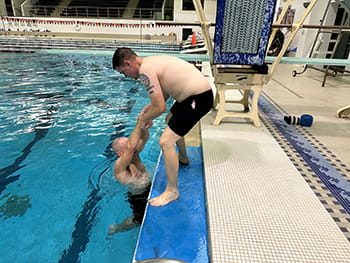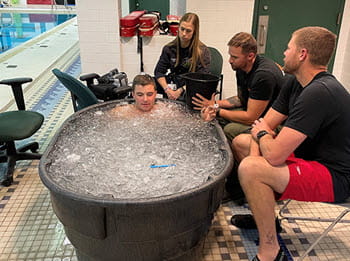The web Browser you are currently using is unsupported, and some features of this site may not work as intended. Please update to a modern browser such as Chrome, Firefox or Edge to experience all features Michigan.gov has to offer.
Training Academy #12: Week 7
Oct. 15-20, 2023
Author: PCO Jeremy Woods, Albion, Michigan
Photo caption: Probationary conservation officers dive into the water and then swim drills to enhance their swimming technique.
Week 7 of Training Academy #12 began Sunday, an immediate transition from Week 6 to continue emergency vehicle operation training. The morning began with performance driving – operating Dodge Chargers at fast speeds around the Michigan State Police Academy drive track. It was exciting and challenging! We also reviewed the DNR Law Enforcement Division pursuit policy. In the afternoon, we drove DNR patrol trucks through various courses. For many of us, it was the first time getting behind the wheel of a DNR patrol truck. This training is extremely important because it helps us understand the limitations of both the trucks and our driving ability.
Photo caption: Probationary conservation officers practice breathing to their side while holding the wall, a drill that will help them swim more efficiently in the water.
Tuesday was our first day of water safety training at the Charlotte Aquatic Center. Due to our different comfort levels in the water, many of us had been nervous about this training since the beginning of the academy. Day one was designed to test our stamina and ability in the water. The instructors showed us proper techniques and ways to swim, tread and enter the water. These techniques are the building blocks for the rest of our training, and the skills we will rely on for water emergencies once we are on duty.
Photo caption: Probationary conservation officers practice pulling water victims in water that is 13 feet deep.
Wednesday built on the water safety skills from day one. We learned how to approach a victim in the water, secure them and swim them through shallow and deep water, then extract them from the water. In many cases, COs work alone and may have to perform a water rescue by themselves. Our water safety instructors stressed how important it was to learn the proper techniques and continue strengthening them. By the end of the day, most of us were feeling much more confident in the water.
Photo caption: Probationary conservation officers practice removing water victims from the water.
Water safety continued Thursday. We warmed up by practicing the various techniques we had been working on, and then completed a scenario designed to represent how tiring and hectic a real water rescue can be. It was exhausting, but the training showed us what we still needed to work on to make sure we could implement smooth water rescues. In the afternoon, we were placed one by one in an ice bath for four minutes. COs regularly patrol on the ice to check people ice fishing, and falling through the ice into the freezing water is a legitimate danger – the ice bath prepares us for how the bitter cold affects our bodies. Some people handled it better than others.
Photo caption: Conservation officers work on the ice while conducting snowmobile patrol and checking people who are ice fishing. Sitting in the ice bath during the academy prepares them for what it will feel like if they fall through the ice.
Friday, the final day of water safety, we were all tired and sore from the physical week but knew we had to keep pushing to successfully complete this portion of the academy. We were put through another scenario in which we had to rescue an active drowning victim and extract them from the water using all the techniques we learned throughout the week. This was by far the most challenging training we have gone through, but it will make us better COs. I can confidently say that we all feel much more confident in our water abilities now that we have completed this training. Water safety was a major hurdle that we got over as a team.
Photo caption: Probationary conservation officers learn how to use a backboard in the water to stabilize someone with a head, neck or back injury.





